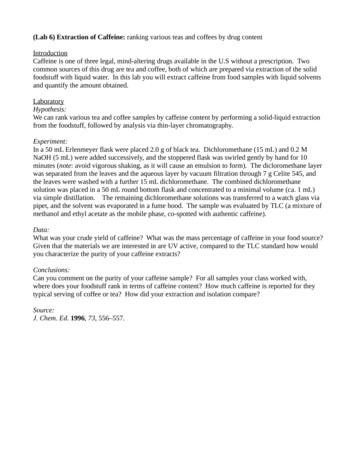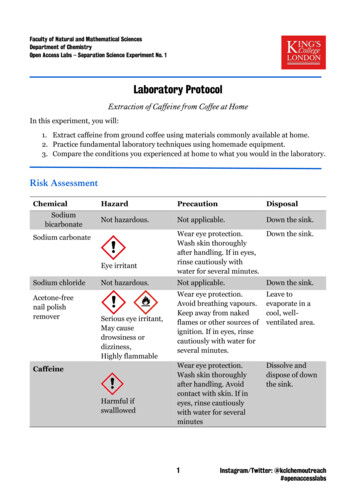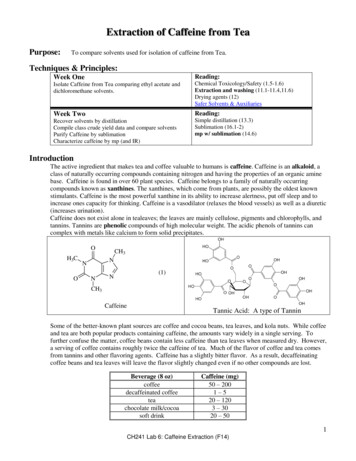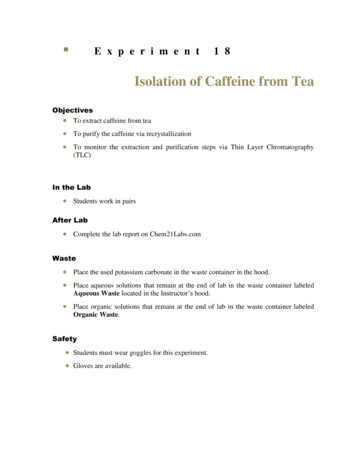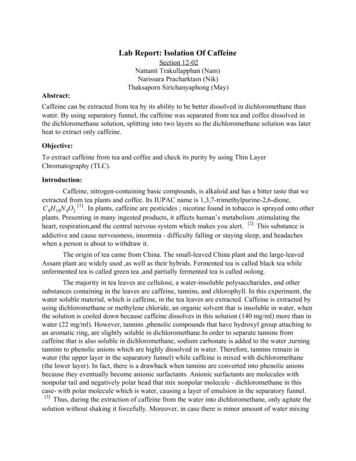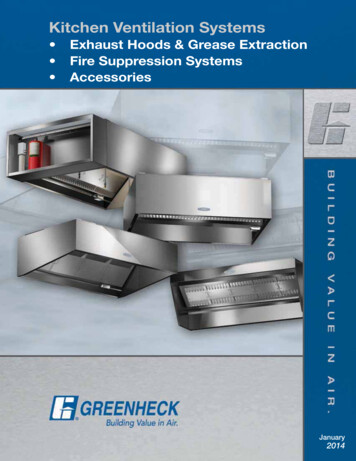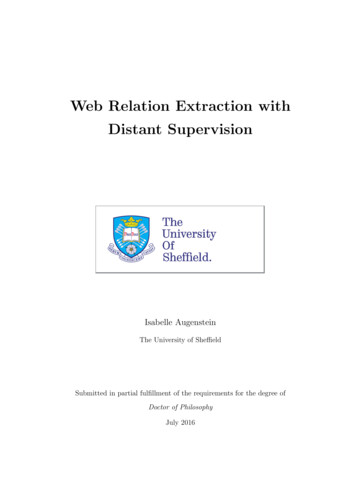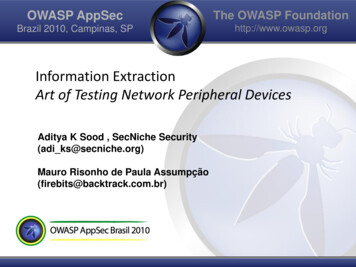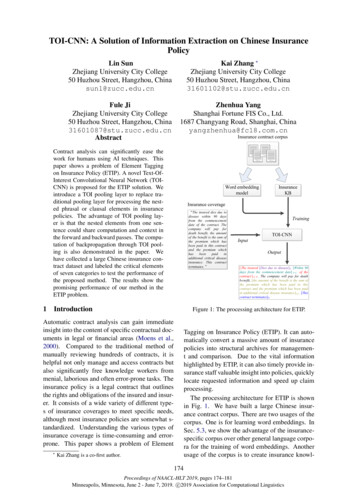
Transcription
International Journal of Advanced Research in Chemical Science (IJARCS)Volume 6, Issue 9, 2019, PP 11-19ISSN No. (Online) 2349-0403DOI: cjournals.orgExtraction of CaffeineAniket Chaugule, Hitesh Patil, Shreyans Pagariya, Pradnya Ingle*Associate Professor Department of Chemical Engineering, Shivajirao S Jondhale College of Engineering,Dombivli (E), 421201, University of Mumbai, India*Corresponding Author: Pradnya Ingle, Associate Professor Department of Chemical Engineering,Shivajirao S Jondhale College of Engineering, Dombivli (E), 421201, University of Mumbai, IndiaAbstract: Caffeine is a chemical found in coffee, tea, cola, guarana, mate, and other products.Caffeine is oneof the most commonly used stimulants among athletes. Taking caffeine, within limits, is allowed by theNational Collegiate Athletic Association (NCAA). Urine concentrations over 15 mg/mL are prohibited. Ittakes most people about 8 cups of coffee providing 100 mg/cup to reach this urine concentration. The aim ofthis study is to determine the concentration of caffeine in reputed tea types and coffee. The Technique usedhere is Liquid-Liquid Extraction to extract caffeine. The Study also focused whether we can extract asignificant amount of caffeine using different extracting solvents and different bases.Keywords: Caffeine, Liquid-Liquid Extraction and Iodometric back titration1. INTRODUCTIONCaffeine is a naturally occurring chemical stimulant found in the leaves, seeds and fruits of anumerous plant species of a group of compounds called trimethylxanthine. Its chemical formula is C 8H10 N4 O2. Caffeine is most commonly used to improve mental alertness, but it has many other uses.Caffeine is used by mouth or rectally in combination with painkillers (such as aspirin and acetaminophen)and a chemical called ergotamine for treating migraine headaches. It is also used with painkillers forsimple headaches and preventing and treating headaches after epidural anesthesia.1.1. Properties of Caffeine Systematic name:1,3,7-trimethyl-1H-purine- 2,6(3H,7H)-Dione Other name: 1,3,7-trimethylxanthine & 1,3,7-trimethyl-2,6-dioxopurine Molecular formula: C8H10N4O2 Molecular mass: 194.19 g/mole Melting point: 238 C Solubility in water: slightly soluble1.2. Health Benefits of Caffeine Research indicates that caffeine may help protect human brain cells, which lowers the risk ofdeveloping some diseases, such as Parkinson’s. Regular cups of coffee may stimulate the gallbladder and reduce the risk of gallstones. Caffeine causes the blood vessels to constrict, which may help relieve some headache pain. Coffee reduces inflammation and may help prevent certain heart related illnesses. Treats Migraine. Relieves Asthma Attack Increases the potency of analgesics. Caffeine is also used for weight loss and type 2 diabetes.International Journal of Advanced Research in Chemical Science (IJARCS)Page 11
Extraction of Caffeine Very high doses are used, often in combination with ephedrine, as an alternative to illegal stimulants. Caffeine creams are applied to the skin to reduce redness and itching in dermatitis.1.3. Adverse Effects of Caffeine There is a significant association between drinking caffeinated coffee and the decrease of bonemineral density, which leads to osteoporosis. The daily consumption of caffeinated drinks can increase blood sugar levels and cause problemsfor people with diabetes. Caffeine is a diuretic and can cause dehydration. Caffeine can prevent some from falling asleep and interferes with deep sleep, which can lead tofatigue during the day.The level of caffeine can vary depending on what is consumed. A piece of chocolate may have aslittle as five milligrams while energy drinks contain as much as 160 milligrams. Make sure to read thelabels of pain medications and diet pills as products can have levels of caffeine as high as 200milligrams. Michigan State University Extension recommends moderate doses of caffeine, 200 to 300milligrams per day, which is equivalent to two to four cups of brewed coffee and is considered safefor most adults. If you are consuming more than 500 to 600 milligrams of caffeine per day, whichequals four to seven cups of coffee, you may be prone to health problems including insomnia,nervousness, nausea or gastrointestinal problems, elevated heartbeat, headaches, etc. If you areexperiencing unusual side-effects associated with the consumption of foods with caffeine, you shouldconsult your physician.1.4. How Does Caffeine Works?Caffeine works by stimulating the central nervous system (CNS), heart, muscles, and the centers thatcontrol blood pressure. Caffeine can raise blood pressure, but might not have this effect in people who useit all the time. Caffeine can also act like a “water pill” that increases urine flow. But again, it may not havethis effect in people who use caffeine regularly. Also, drinking caffeine during moderate exercise is notlikely to cause dehydration.Fig1. Structure of caffeineTable1. Caffeine Content of Common Food and DrugsEspressoCoffee, Regular, BrewedInstant CoffeeCoffee, DecaffeinatedTeaCocoaMilk ChocolateBaking ChocolateCoca-Cola ClassisJolt ColaAnacin Bromo Seltzer MidolExcedrin Extra StrengthDexatrimDietacVivarinDristanNo-Doz120 mg per 2 Oz103 mg per cup57mg per cup2 to 4 mg per cup30-75 mg per cup5-40mg per cup6mg per Oz35mg per Oz46mg per 12 Oz72mg per 12 Oz32mg per pill65mg per pill200mg per pill16mg per pill100mg per pillInternational Journal of Advanced Research in Chemical Science (IJARCS)Page 12
Extraction of CaffeineIn table 1 the mentioned beverages and drugs are frequently used and it reveals that among them,Espresso contains the maximum amount of caffeine as compared to other beverages and drugs.In its pure form, caffeine is a white crystalline powder that tastes very bitter. It is medically useful tostimulate the heart and also serves as increasing the rate of urine excretion. It is one of the moststudied ingredients in the food supply. The most commonly known sources of caffeine are coffee andcocoa beans, guarana, and tea leaves. The amount of caffeine in food and beverage products variesdepending on the serving size, the type of product and preparation method. Tea which we generallydrink is made from the leaves of an Asian evergreen known as Camellia sinensis. The presence ofcaffeine in plants helps to prevent them from insects and other herbivores with the compound’s bittertaste and stimulating qualities. The caffeine content of tea leaves depends on the variety and wherethey were grown; most tea has 3-5% by weight. The optical transition properties of caffeine weremeasured in different solvents (dichloromethane, water, chloroform and ethyl acetate). Caffeine hashighest optical transitions in dichloromethane than the other solvents. Caffeine can be extracted moreat the boiling temperature than at 30 C. Caffeine had been widely used in the food and pharmaindustry. The cost of extraction of caffeine from natural source is more. Research has been taken toextract it from natural source more economically.Table2. Caffeine Content in Tea/Coffee Sample (Extraction with water)TEA/COFFEE SAMPLESBrook Bond Red LabelAVTEastern EasteaPalat3 RosesKannan DevanBru gold CoffeeAVT CoffeeAMOUNT OF CAFFEINE (gm)0.010.030.020.040.020.010.680.62These are some of the popular Tea and coffee brands among which Bru Gold Coffee contains themaximum amount of caffeine, whereas Kannan Devan contains the least as mentioned in Table 22. MATERIALS AND METHODSLiquid–liquid extraction (LLE) is a method to separate compounds or metal complexes, based on theirrelative solubilities in two different immiscible liquids, usually water (polar) and an organic solvent(non-polar). There is a net transfer of one or more species from one liquid into another liquid phase,generally from aqueous to organic. The transfer is driven by chemical potential, i.e. once the transferis complete, the overall system of protons and electrons that make up the solutes and the solvents arein a more stable configuration (lower free energy). The solvent that is enriched in solute(s) is calledextract. The feed solution that is depleted in solute(s) is called the raffinate. LLE is a basic techniquein chemical laboratories, where it is performed using a variety of apparatus, from separatoryfunnels to countercurrent distribution equipment called as mixer settlers. This type of process iscommonly performed after a chemical reaction as part of the work-up, often including an acidic work-up.Extraction is a method used for the separation of organic compound from a mixture of compound.This technique selectively dissolves one or more compounds into an appropriate solvent. The solutionof these dissolved compounds is referred to as the extract. In the case of Caffeine extraction from teapowder, the solubility of caffeine in water is 22mg/ml at 25 C, 180mg/ml at 80 C, and 670mg/ml at100 C. Here the organic solvent Dichloromethane is used to extract caffeine from aqueous extract oftea powder because caffeine is more soluble in dichloromethane (140mg/ml) than it is in water(22mg/ml).The dichloromethane - caffeine mixture can then be separated on the basis of the differentdensities of dichloromethane and water because dichloromethane is much denser than water andinsoluble in it. Residual water is separated from dichloromethane by drain out the dichloromethanethrough separating funnel, thus dichloromethane passed through the funnel while polar solvents suchas water is still remaining in the funnel.In the first phase of experimentation screening was carried out in order to determine the maximumcontent of caffeine among black tea, green tea and coffee. The procedure was as follows: 10gm oftea, green tea and coffee sample was taken and boiled for 15 minutes along with the addition of 6gmof sodium carbonate which acts like a base which reacts with tannins to form sodium salts of tannins.International Journal of Advanced Research in Chemical Science (IJARCS)Page 13
Extraction of CaffeineNext step is to filter the solution using vacuum filtration technique. The filtrate obtained is then usedfor liquid-liquid extraction to extract the caffeine into a organic solvent. Dichloromethane is used assolvent in liquid-liquid extraction because caffeine has higher solubility in Dichloromethane ascompared to other solvents. After separation of organic layer from the separating funnel it is then keptfor evaporationso as to evaporate the dichloromethane present in it. Now raw crude yellowish caffeineis further sent to recrystallisation in order to obtain pure white caffeine. Ethanol is used forrecrystallisation as solvent.Now after carrying out the above experiment and comparing the quantities of the caffeine obtained,we came to the results that caffeine content is higher in coffee as compared to green tea and black tea.The next attempt of experimentation is to extract caffeine using different solvents and different bases.Using coffee for further extraction procedure because caffeine content is more in coffee as comparedto green tea, black tea and coffee. First of all, keeping the base as constant i.e. sodium carbonate andvarying solvents we are going to extract caffeine from coffee. 10 gm of coffee was boiled for 15-20mins with sodium carbonate as base. This step is called as Solid-Liquid Extraction. Now the next stepis filtration which is carried using vacuum filtration instead of gravity filtration so as to minimize thetime required for filtration. Filtrate obtained is used for liquid-liquid extraction using differentsolvents such as dichloromethane, acetone and ethanol. These solvents are not used simultaneously.For each solvent, different liquid liquid extraction is carried out and then the product obtained whichis present in the organic layer is kept for evaporation. Then the quantity of caffeine from each of thesolvent used is compared in the results.The final step of the experimentation is to determine what happens to the quantity and quality ofcaffeine when we change the base used during solid-liquid Extraction. For this again 10 gm of coffeeis used and boiled along with the addition of sodium hydroxide as base instead of sodium carbonate.Then again vacuum filtration is carried out in order to separate the particles of coffee beans present.Then liquid-liquid extraction is used to separate caffeine in organic layer. Then organic layer obtainedis kept for evaporation and the product obtained is compared.The procedure along with some snapshots are depicted as follows:In order to extract caffeine from tea, several techniques are accompanied. First, a solid-liquidextraction must take place in order to get the solid natural product into the liquid solvent. This can bedone by boiling tea leaves with the addition of sodium carbonate as a base. Further to separate thetannins vacuum filtration is used.Fig2. Solid-Liquid ExtractionFig3. Vacuum FiltrationInternational Journal of Advanced Research in Chemical Science (IJARCS)Page 14
Extraction of CaffeineAfter Vacuum Filtration, Liquid-Liquid extraction is used to separate caffeine in organic layer.Solvent used for solid liquid extraction is sodium carbonate whereas solvent used for liquid-liquidextraction is Dichloromethane (CH2Cl2) (Note- Dichloromethane can irritate your skin so do nothandle Dichloromethane bare handedly).Fig4. Liquid-Liquid ExtractionNow the next step is to keep the organic layer for evaporation of solvent which is dichloromethane.After evaporation of solvent the left product is raw crude caffeine which is further sent to analysis.Fig5. Crude CaffeineNote: The sodium carbonate acts as a base - you could use sodium hydroxide instead. When you boiltea leaves tannins dissolve in the water as well as the caffeine. If you do not use a base the tanninswill also be extracted into the solvent (i.e. methylene chloride) used in the subsequent extraction. Thebase converts the tannins in
Extraction is a method used for the separation of organic compound from a mixture of compound. This technique selectively dissolves one or more compounds into an appropriate solvent. The solution of these dissolved compounds is referred to as the extract. In the case of Caffeine extraction from tea
